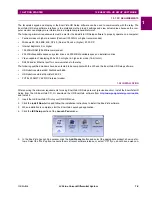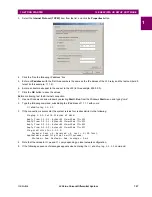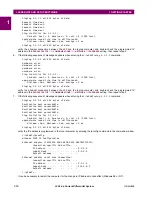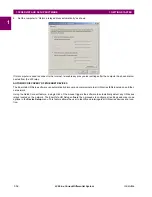
1-2
L30 Line Current Differential System
GE Multilin
1.2 UR OVERVIEW
1 GETTING STARTED
1
1.2UR OVERVIEW
1.2.1 INTRODUCTION TO THE UR
Historically, substation protection, control, and metering functions were performed with electromechanical equipment. This
equipment was gradually replaced by analog equipment, most of which emulated the single-function approach of their elec-
tromechanical precursors. Both technologies required expensive cabling and auxiliary equipment to produce functioning
systems.
Recently, digital electronic equipment has begun to provide protection, control, and metering functions. Initially, this equip-
ment was either single function or had very limited multifunction capability, and it did not significantly reduce the cabling and
auxiliary equipment required. However, recent digital relays are multifunctional, reducing cabling and auxiliaries signifi-
cantly. These devices also transfer data to central control facilities and software using electronic communications. The
functions performed have become so broad that many users now prefer the term Intelligent Electronic Device (IED).
It is obvious to station designers that the amount of cabling and auxiliary equipment installed can be even further reduced,
to 20% to 70% of levels common in 1990, and achieve large cost reductions. This requires placing even more functions
within the IEDs.
Users of power equipment are also interested in reducing cost by improving power quality and personnel productivity, and
in increasing system reliability and efficiency. These objectives are realized through software that is used to perform func-
tions at both the station and supervisory levels. The use of these systems is growing rapidly.
High-speed communication is required to meet the data transfer rates required by modern automatic control and monitoring
systems. Very high speed communications are required to perform protection signaling with a performance target response
time for a command signal between two IEDs, from transmission to reception, of less than 3 milliseconds. This has been
established by the IEC 61850 standard.
IEDs with such capabilities also provide significantly more power system data than was available, enhanced operations and
maintenance, and permit the use of adaptive system configuration for protection and control systems. This new generation
of equipment is easily incorporated into automation systems, at both the station and enterprise levels. The GE Multilin Uni-
versal Relay (UR) series meets these goals.
Summary of Contents for L30
Page 10: ...x L30 Line Current Differential System GE Multilin TABLE OF CONTENTS ...
Page 30: ...1 20 L30 Line Current Differential System GE Multilin 1 5 USING THE RELAY 1 GETTING STARTED 1 ...
Page 370: ...5 244 L30 Line Current Differential System GE Multilin 5 10 TESTING 5 SETTINGS 5 ...
Page 464: ...A 10 L30 Line Current Differential System GE Multilin A 1 PARAMETER LISTS APPENDIX A A ...
Page 600: ...C 30 L30 Line Current Differential System GE Multilin C 7 LOGICAL NODES APPENDIX C C ...
Page 610: ...D 10 L30 Line Current Differential System GE Multilin D 1 IEC 60870 5 104 APPENDIX D D ...
Page 622: ...E 12 L30 Line Current Differential System GE Multilin E 2 DNP POINT LISTS APPENDIX E E ...
Page 634: ...F 12 L30 Line Current Differential System GE Multilin F 3 WARRANTY APPENDIX F F ...
Page 644: ...x L30 Line Current Differential System GE Multilin INDEX ...





































